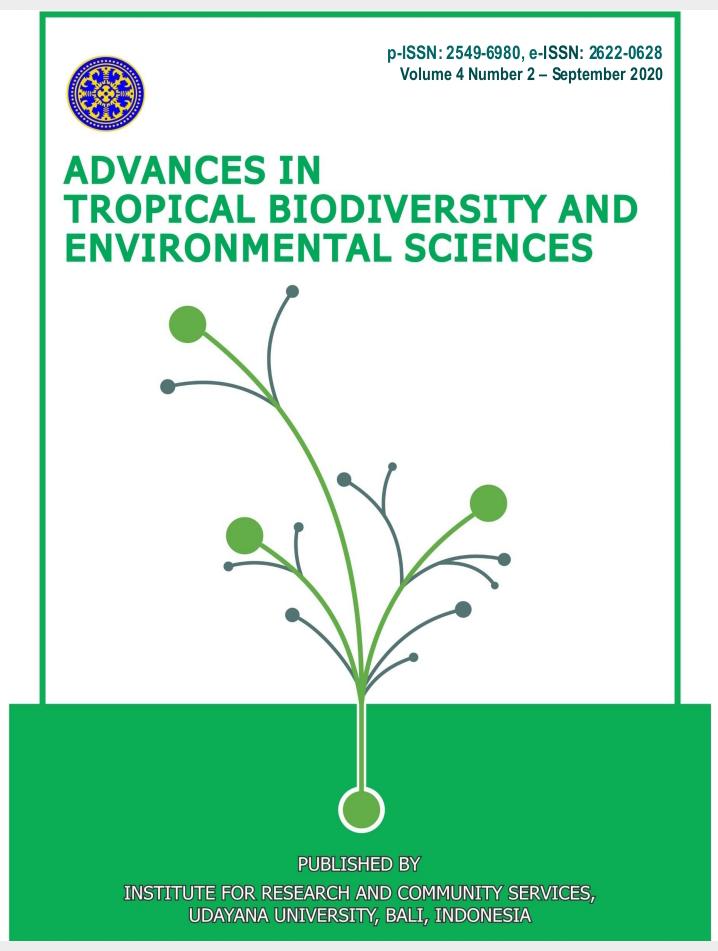Identification and Analysis of Diversity of Soil Microorganism Colonies in Limestone Reclamation Land
Abstract
Reclamation of land used for mining is very important because it is related to microbial activity in the soil which has an impact on soil fertility. The purpose of this study is to identify and analyze the diversity of bacterial colonies in the reclaimed land of the former Limestone Mining. The method used in this research was a laboratory experimental method. The results of the study showed that 6 bacterial isolates were found and the highest total plate count in GPS land (GPS system) is 1.97 X 106 cfu, the dominant colony characteristics were irregular shapes, flat edges and milky white color.
Downloads
References
[2] Hari K, TA Wahyudi, E Husen. 2017. Pengaruh Rizobakteria Pemacu Tumbuh Dam Toleran Kekeringan Serta Kelimpahan Dan Aktivitas Mikroba Tanah Terhadap Tanaman Jagung (Zea mays L.). Biospecies 10(1): 25-36.
[3] Nurtjahyani SD, D Oktavitria, S Wuan, I Cintamulya, N Maulidina, E Purnomo. 2018. Identifikasi Dan Karakterisasi Keanekaragaman Mikoriza Pada Lahan Reklamasi Bekas Penambangan Batu Kapur Di Kabupaten Tuban. In Prosiding Seminar Nasional VI Hayati 2018, pp. 291-99.
[4] Lay B. 1994. Analisis Mikroba di Laboratorium, Grafindo Persada, Jakarta.
[5] Cappuccino JG, N Sherman. 2008. Microbiology: A Laboratory Manual, Pearson, New York.
[6] Sneath PHA, NS Mair, ME Sharpe, JG Holt. 1986. Bergey’s Manual of Systematic Bacteriology Vol.2, Williams and Wilkins, Baltimore.
[7] Sriwahyuni. 2012.Rehabilitation of Mine wasteland PT. Inco Sorowako with Organic Matter, Bacteria Solubilizing of phosphate and Bacteria Reducing of Nickel. Jurnal Riset Industri, 6(2): 149-155.
[8] Lambui O, M Jannah. 2017. Isolation and Identification of Soil Bacteria in Forest around Lake Kalimpa’a, Lore Lindu National Park Area, Central Sulawesi. Online Journal of Natural Science, 6(1):73-82.
[9] Neneng L, Saraswati D. 2019. Reclamation of Degraded Land Ex Gold Mining Area using Bioremediation and Phytoremediation Methods. EnviroScienteae Vol. 15(2):216-225.
[10] Erfandi D. 2017. Pengelolaan Lansekap Lahan Bekas Tambang: Pemulihan Lahan dengan Pemanfaatan Sumberdaya Lokal (In-Situ. Jurnal Sumberdaya Lahan Vol. 11(2): 55-66.
[11] Dwijoseputro, D. 2005. Dasar-Dasar Mikrobiologi, Djambatan, Jakarta.
[12] Gautam KK, VK Tyagi. 2006. Microbial Surfactants: A Review. J. Oleo Sci. 55(4): 155-166.
[13] Utami DS, Priyani N, Munir E. 2012 Isolasi dan uji potensi bakteri tanah pertanian berastagi sumatera utara dalam mendegradasi fungisida antracol berbahan aktif propineb. https://media.neliti.com/media/publications/221113-none.pdf.
[14] Soedarsono MJ, L Endang. 2008. Biologi Tanah. Pasca Sarjana UI. Jakarta
[15] Fiantis D. 2015. Morfologi Dan Klasifikasi Tanah.Penerbit: Minangkabau Pres.
[16] Christanto J. 2016. Analisis Sumber Daya Alam Dan Lingkungan. Penerbit: Erlangga.













